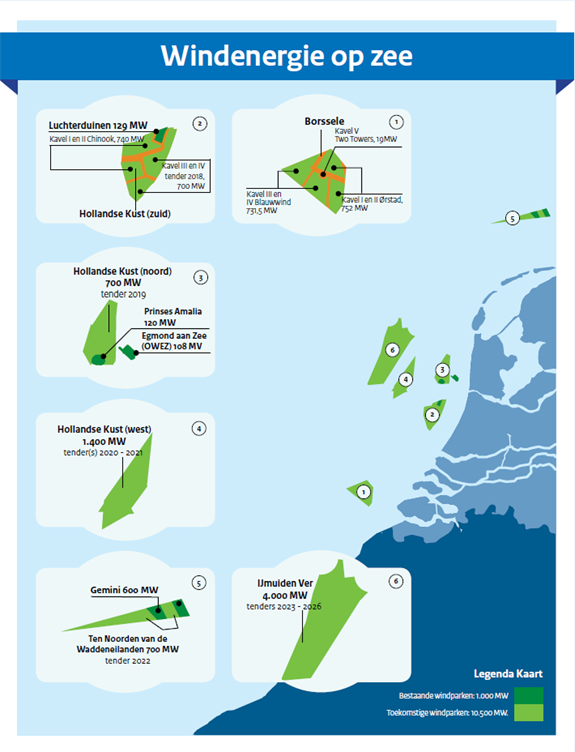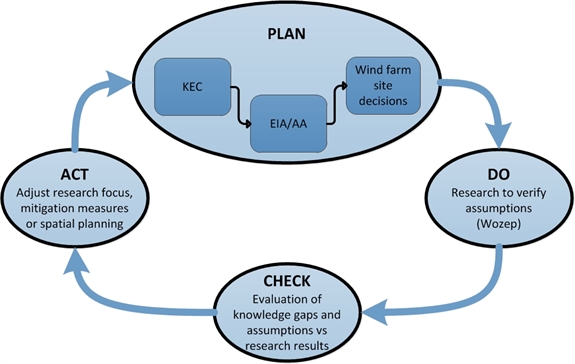Wozep research programme investigates the ecological impact of offshore wind farms.
The Netherlands has ambitious plans for renewable energy. Research is needed to understand the effects on protected species and habitats, and to develop the appropriate mitigation measures.
The Dutch Ministry of Economic Affairs and Climate Policy is responsible for implementing the road map for offshore wind energy while ensuring that the impact on birds, bats and marine mammals remains within the acceptable levels set by the relevant legislation. The Ministry asked Rijkswaterstaat in 2016 to initiate a research programme (Wozep: the Dutch Governmental Offshore Wind Ecological Programme, 2016-2023) to develop knowledge in this field. Wozep is not the first research programme to address these issues: it draws on research in the previous decade looking at prioritised vulnerable species.
Wozep objectives
There are three objectives for monitoring and research in Wozep:
• The reduction of levels of uncertainty relating to knowledge gaps and assumptions in the cumulative effect assessment (KEC), Environmental Impact Assessments (EIA) and Appropriate Assessments (AA).
• The reduction of levels of uncertainty about knowledge gaps and assumptions relating to the long-term impacts and upscaling of offshore wind farms.
• The determination of the effectiveness of mitigation measures.
 Figure 1: Locations of present (dark green) and planned (route map 2030) offshore wind parks (source: RVO)
Figure 1: Locations of present (dark green) and planned (route map 2030) offshore wind parks (source: RVO)
Our research areas
The effects of wind farms can be broken down into two broad categories: effects above and below the surface. The impact on marine mammals (the harbour porpoise, and the harbour and grey seal) of impulsive underwater noise caused by pile-driving during the construction of wind farms is one of the main underwater research topics. The focus above the surface is on the risks for birds and bats of colliding with rotor blades, and the displacement of seabirds by wind farms, resulting in a loss of habitat. Alongside the research looking at these priority species, the programme is also addressing the long-term development of benthos in wind farms and the effect of electromagnetic fields.
In addition to this species-based research, Wozep also looks at the possible, more long-term, ecosystem impact of the development of large areas with offshore wind farms. The effects on physical and hydrodynamic processes are being studied, as is the possible effect on the lower trophic groups.
From the outset, Wozep has focused on understanding cause-effect relations, assessing impacts, and efforts to formulate and to evaluate mitigation measures.
Using the results
The Wozep results are included in Environmental Impact Assessments (EIA), Appropriate Assessments (AA) and the cumulative effect assessment (KEC). The KEC is used to calculate the cumulative effects of present and planned wind farms on bats, birds and marine mammals. If the effects exceed the acceptable impact levels, the KEC proposes mitigation measures for inclusion in decisions about wind-farm sites taken by the Ministry of Economic Affairs and Climate Policy. The research on sound propagation and the effects on marine mammals, for example, resulted in sound thresholds for pile-driving. Another example of how the results are put into practice is the mitigation measure to prevent bat casualties due to collisions; this measure was based on more detailed knowledge about the exact weather conditions in which bats tend to be present in the wind farms.
The process of identifying knowledge gaps, conducting research, evaluating results, and using improved knowledge in the various assessments and decisions about wind-farm sites has led to a continuous ‘plan – do – check – act’ cycle. This iterative process allows us to make ongoing improvements to both the Wozep research programme and the tools that draw on the knowledge (see figure 1). The cycle integrates not only the results from Wozep but also the results from other research projects (national and international).

Figure 2: Relationship between Wozep, KEC and site decisions in the PDCA cycle
We are currently updating the KEC with the knowledge developed over the past two years. Cumulative effects have been calculated again to identify any change in the impact on protected species compared with the calculations from 2015. This newsletter will inform you about the results as soon as they have been finalised.
The newsletter will be sent to Wozep stakeholders twice a year to describe the progress of the research and share the latest insights. It will include a number of articles about recently-completed research projects or new research activities. As well as describing results, we will also set out at the consequences of these results for decisions about wind-farm sites. All the articles will include links to our website, where you can find the full research reports.